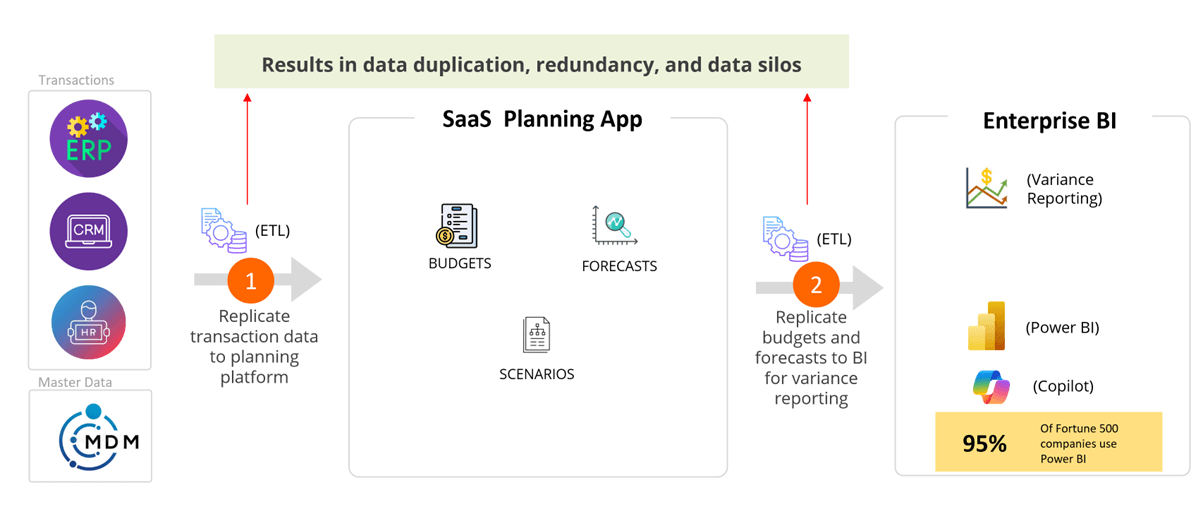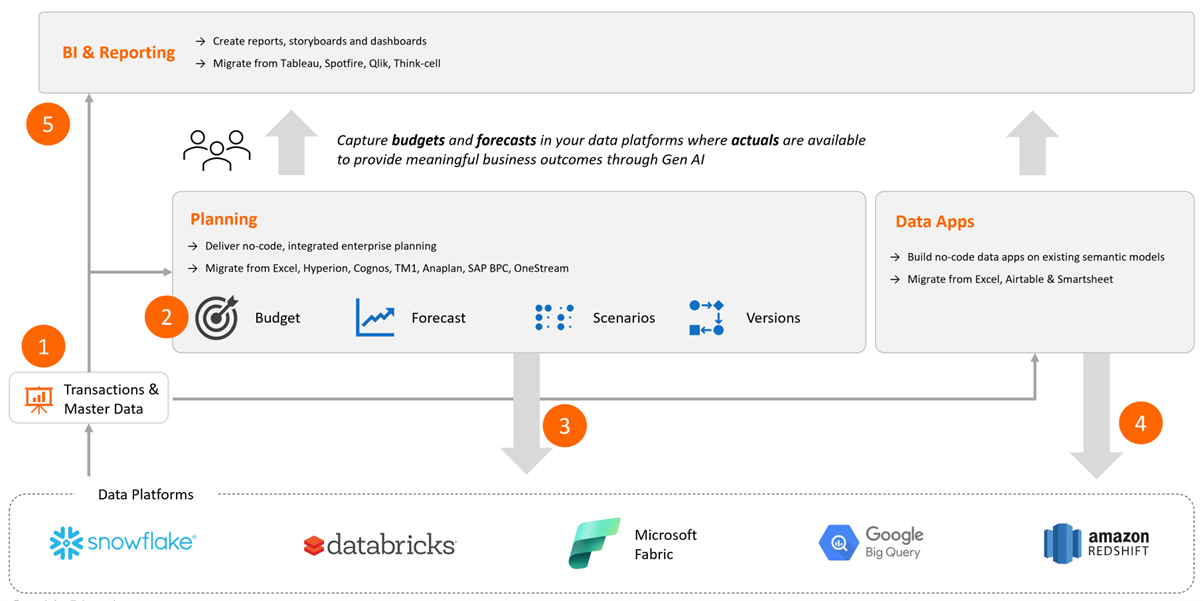Let's talk about something that's genuinely shifting the ground beneath our feet in the world of data & analytics: Native Apps on Modern Data Platforms. This isn't just another buzzword; it's a fundamental change in how we build, deploy, and use applications that rely heavily on data.
It is a game changer that will help us move away from a tangled web of data copies towards a much smarter, unified future.
Think about how most companies operate today. You've got your core systems – ERPs, CRMs, HR tools. Then you add specialized applications, maybe some cool SaaS tools for marketing, sales, or finance. And where does all the important data go to live? Increasingly, it's consolidated in a powerful modern data platform like Snowflake, Databricks, Microsoft Fabric, Google BigQuery, or Amazon Redshift. These platforms are amazing hubs for storing, processing, analyzing and governing vast amounts of information.
But here's the rub: What happens when a specialized application needs data?
Too often, the answer is: replicate it.
Data gets extracted from the central platform, transformed, and loaded into the application's separate environment. Even seemingly "modern" SaaS applications rely on this model. They might live in the cloud, but they still create their own data silo, forcing you to pump data out of your governed, central platform into their world.
This constant replication creates a mess:
This "move the data to the app" approach, frankly, is a legacy way of thinking, even when wrapped in a shiny (SaaS) package.
Modern data platforms (Snowflake, Databricks, Fabric, BigQuery, Redshift, etc.) have become the central gravity for enterprise data for good reason. They offer scalability, performance, and increasingly sophisticated governance capabilities. The logical next step? Bring the applications to the data, not the other way around.
Enter Native Apps.
These aren't just applications that connect to your data platform. They are applications designed to run directly inside the data platform environment. Think of it like installing an app on your phone – it uses the phone's operating system and resources directly. Similarly, a native app runs securely within the data platform's infrastructure, leveraging its compute power and accessing the data where it already lives. There is no need to move data around across platforms!
Let’s look at a sample use case for how Native Apps can revolutionize industry or domain-specific applications.
Consider the world of Financial Planning & Analysis (FP&A) – involving budgeting, planning, and forecasting. Traditionally, dedicated FP&A tools require transactional data from ERPs, CRMs, HR systems, and maybe a dozen spreadsheets. It also requires master data for planning & reporting, often coming from Master Data Management (MDM) apps. The replication of data is a manual, error-prone process. Reconciliation is a constant battle. You can often walk into a meeting and hear ‘But my report shows a different number’.
Now, imagine a native planning application running directly on your Snowflake or Databricks.
This shift moves planning from a periodic, backward-looking exercise to a continuous, forward-looking strategic function. Companies can react faster to market changes because their plans are grounded in current reality.
The benefits extend beyond just planning. Historically, Business Intelligence (BI) and reporting and enterprise planning operated in different silos. You might do your planning in one tool, then export summaries to a data warehouse, and then point your BI tool (like Power BI, Tableau, or Looker) at that summarized data for reporting. This disconnect between planning and reporting often leads to inconsistencies and an inability to drill down from a report into the underlying planning details.

Even your seemingly 'modern' SaaS app follows a legacy architecture promoting data silos and replication
With native apps, planning and reporting can happen within the same unified environment, often leveraging the same user interface or tightly integrated components.

Native data apps run in your data platform, using the data platform’s resources
This unification streamlines analysis and ensures everyone, from executives to analysts, is working from the same playbook. Microsoft Fabric, for example, aims to provide this unified experience by integrating data movement, warehousing, BI and AI capabilities on one platform.
Artificial Intelligence and Machine Learning thrive on data – lots of high-quality, accessible data. The old model of fragmented, replicated data is a major roadblock for AI initiatives.
Imagine this – if your enterprise planning platform stores all planning information in a ‘walled garden’, and if you use Power BI for enterprise reporting (like 95% of all Fortune 500 firms), which AI would you use? Would that be Microsoft CoPilot for which you already own licenses as part of Office 365 bundle? Or would you purchase an AI subscription from your planning software vendor?
In addition, how would AI reconcile operate on data sitting in multiple silos?
Native apps running on a central data platform change the game for AI:
Imagine AI directly suggesting forecast adjustments within your native planning app based on real-time sales pipeline changes and macroeconomic indicators pulled directly from the data platform – that's the power this unified approach unlocks.
Let's quickly summarize the differences:
| Feature | Traditional Approach (Data Replication) | Native App Approach (On Platform) |
|---|---|---|
| Data Movement | High (Extract, Load to App) | Minimal/None (Compute moves to Data) |
| Data Location | Siloed copies in multiple apps + central platform | Primarily within the central, governed platform |
| Latency | High (Batch updates, stale data) | Low (Near real-time access) |
| Complexity | High (Managing pipelines, integration points) | Lower (Simplified architecture) |
| Governance | Difficult (Multiple copies, varying policies) | Easier (Centralized control) |
| Cost | High (Integration, storage, compute overhead) | Significantly Lower (Reduced replication/movement) |
| AI Integration | Challenging (Data prep, access issues) | Streamlined (Unified data access) |
| Scalability | Performance issues with data volume growth | Excellent with the option of push-down SQL |
The shift towards native applications running directly on modern data platforms isn't just a minor technical adjustment; it's a fundamental change in how we'll build and use enterprise software. It promises less complexity, lower costs, faster insights, and more intelligent operations by finally breaking down the data silos that have plagued businesses for decades.
By bringing compute to the data, we're paving the way for truly unified planning, reporting, and AI, all powered by the single source of truth residing in platforms like Snowflake, Databricks, Fabric, BigQuery, and Redshift. Keep an eye on this space – it's where the future of data-driven business is being built.
Lumel offers end-to-end enterprise performance management for your modern data platform. This includes Lumel Planning, Lumel Data Apps and Lumel BI for reporting and analytics. The firm was recognized as the best new vendor for EPM in 2024.
To follow our experts and receive thought leadership insights on data & analytics, register for one of our webinars.